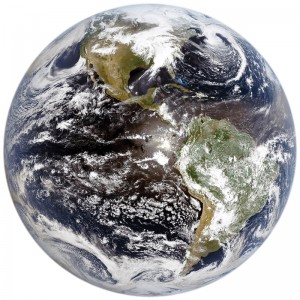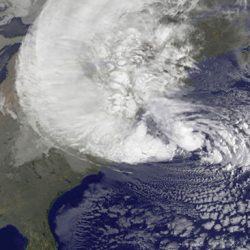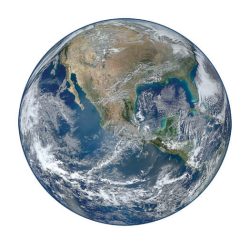Earth in HD
“Meteorologists are drooling.” That was the report from the Washington Post when the GOES–16 satellite sent back its first images of Earth in January.

A true-color composite from the satellite, generated by UW researchers in March, shows clouds and the Earth’s surface, including North and South America, and snow cover over Wisconsin. UW–Madison CIMSS and NOAA
From wispy swirls of white against a deep blue expanse, to bold-hued panels of North America, to plumes of smoke from wildfires, the images offer views never seen before and — for the first time in decades — views of Earth at night and in true color during the day.
“We’ve been looking at the same satellite data for most of my career, and this is so revolutionary, it’s like going to HDTV,” says Dan Baumgardt ’90, MS’92, National Weather Service science and operations officer in La Crosse, Wisconsin. “We can start to identify features in the atmosphere we couldn’t see before.”
GOES stands for geostationary operational environmental satellite, and this is the 16th in the GOES series, the first of which launched in 1975. The satellite offers three times more imaging capability, four times more spatial resolution, and five times more coverage than previous GOES satellites, says Tim Schmit ’85, MS’87, a National Oceanic and Atmospheric Administration (NOAA) scientist based at UW–Madison.
Schmit and colleagues at the UW’s Space Science and Engineering Center, the Cooperative Center for Meteorological Satellite Studies, and NOAA’s National Environmental Satellite, Data, and Information Service began preparing for GOES–16 in the late 1990s.
From his Twitter handle, @GOESguy, Schmit has enjoyed watching social media users wonder over the satellite’s capabilities and learn how to use its data. In addition to stunning images, the satellite offers improved hurricane forecasting, aviation-route planning, and wildfire tracking.
One of Schmit’s favorite tweets came from a National Weather Service employee who’d be off work when the satellite’s data were first released: “Something to look forward to at 4 am tomorrow!”
Published in the Summer 2017 issue



Comments
No comments posted yet.